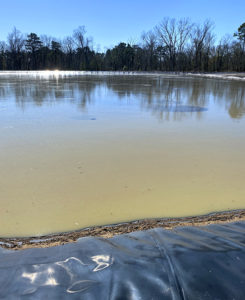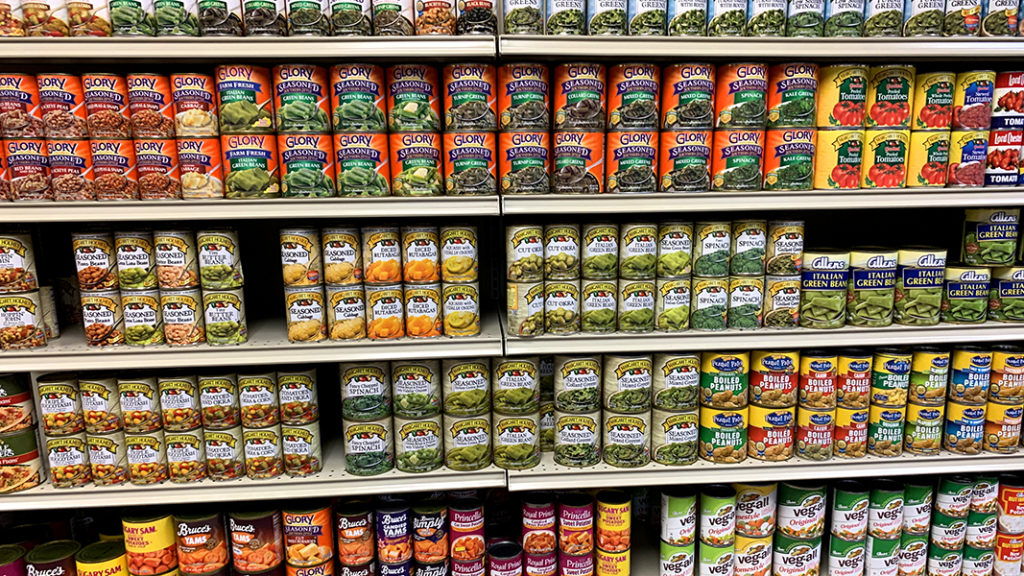Top: GreenGas USA is working with McCall Farms to cover the farm’s wastewater holding ponds to capture methane to upgrade into RNG.
Nora Goldstein
Last month, Duke University in Durham, North Carolina, announced a milestone agreement with Charleston, South Carolina-based GreenGasUSA to purchase 95,000 MMBtus of renewable natural gas (RNG), which Duke will use in its steam plants on campus, replacing about 6% of the fossil natural gas currently being combusted. The 20-year deal will edge Duke even closer to meeting its net-zero greenhouse gas emissions commitment, which it has pledged to meet by 2024. I zoomed with Tanja Vujic, the University’s former Director of Biogas Strategy and the founding director of the Duke Carbon Offsets Initiative, to get her insights about the deal and discuss how controlling methane emissions from organic waste resources has factored into Duke’s efforts to become climate neutral. Vujic is now president of WasteNot Strategies, LLC in Durham, a biogas, climate and environmental consultancy, while also continuing her affiliation with Duke as an Assistant Professor of the Practice at the Nicholas School of the Environment.

The two wastewater holding ponds are part of McCall Farms’ wastewater treatment system. One is covered and the other (above) will be covered as part of the RNG project. Photos by Tanja Vujic
BioCycle: The RNG purchased from GreenGas USA will come from a food waste processing facility. Can you provide more details about the project and its development?
Vujic: The GreenGas project will supply RNG from biomethane currently being off-gassed from wastewater holding ponds at McCall Farms in Effingham, South Carolina, a family-owned business established in the 1950s that produces Southern-style canned vegetables. McCall sources nearly 700 million pounds of produce annually from farmers in the region, of which approximately 105 million pounds come from North Carolina farmers. McCall Foods uses the wastewater ponds as part of its wastewater treatment system. The RNG will come from biogas captured from two existing in-ground wastewater storage ponds, one that is already covered but venting to the atmosphere and one that will be covered as part of the project. GuildAssociates will provide the gas clean up system.

McCall Farms in Effingham, South Carolina is a family-owned business established in the 1950s that produces Southern-style canned vegetables. All brands made by the company are represented in the photo.
GreenGas estimates gas output of 900 MMBtu/day, of which Duke will be one of several offtakers that also includes Berkshire Hathaway Energy. GreenGas does not participate in the federal Renewable Fuels Standard RIN market but focuses instead on providing RNG to help customers meet in-house low-carbon energy and fuel needs. On the injection side, GreenGas owns an injection point on the BHE Carolina Gas Transmission line, and the RNG will meet the company’s injection standards. On the back end, digestate will be used as fertilizer by farms in the PeeDee region, which covers the northeastern part of South Carolina.
BioCycle: Duke University set an ambitious goal to be carbon neutral by 2024. Can you provide some context on how that goal was established and why?
Vujic: Duke took on its climate neutrality goal in 2007 as part of the American College and University Presidents’ Climate Commitment (ACUPCC). The ACUPCC represented a push to get higher education institutions to reduce or zero out their carbon emissions to address climate change. As part of the commitment, schools were required to pledge to zeroing out their emissions no later than 2050. Rather than accept the 2050 target, Duke instead pushed up its deadline to 2024, which coincides with the 100th anniversary of its investiture. The idea was to match Duke’s academic, research and climate policy leadership to its own operations. Duke didn’t want to just study the problem but rather wanted to be part of the solution, or, in keeping with the University’s mission, “use knowledge in the service of society.”
At the time, you couldn’t just pick up the phone and make a purchase of carbon offsets or renewables. This was particularly the case for Duke, which had not only committed to zeroing out its carbon footprint, but also pledged to source its reductions from local or regional projects that also provided environmental, economic and social benefits beyond greenhouse gas (GHG) mitigation. This lack of supply resulted in a rapid effort to figure out how Duke was actually going to achieve climate neutrality and, essentially, develop its own supply. In 2007, the expectation was that Duke would have to rely heavily on carbon offsets to cancel out its emissions because there weren’t a lot of options in terms of renewables. Over time, however, that focus shifted as more renewable opportunities became available. That’s been the case with RNG and the journey from methane reductions as a carbon offset to using methane — in the form of RNG — as a renewable resource.

Vegetable processing and canning facility at McCall Farms (in background). Biogas captured in covered holding pond is currently being vented.
BioCycle: How does RNG fit into Duke’s climate commitment goal?
Vujic: The path from carbon offsets to RNG seems like a pretty organic one, particularly in hindsight, and is a good example of how building projects and trying things out — especially when coupled with research and analysis — can catalyze change in policy and help to scale development. RNG made sense because Duke needs a lot of thermal energy to run its operations, relying on natural gas for a little more than half of its on campus energy needs. The great thing about RNG is that the purchase of each MMBtu not only cancels out the use of a fossil [gas], but also provides additional carbon reductions associated with the avoidance of the methane that otherwise would have gone up into the atmosphere without the project. This is what Duke called a double dividend effect and why it favored RNG as a carbon reduction strategy. Getting back to your question, Duke deserves a great deal of credit first for making an ambitious neutrality commitment when most of its counterparts, many of them with much smaller footprints, were aiming at 2050 — and for the unusual hands-on approach it took in developing a supply of carbon offsets and, later, RNG.
By unusual, I mean academic institutions do not normally take such an active role. So, when Duke realized it couldn’t just pick up a phone (or go to a website) to get the kind of offsets it wanted and, later, RNG for its natural gas steam plants, it went out into the marketplace and made it happen. I think it’s fair to say Duke played a major role in creating the development of biogas we see in North Carolina and the Southeast today. While we’re not quite to the point of just picking up the phone, we’re certainly a lot closer.
BioCycle: It seems that “active role” goes beyond just procuring needed offsets. Can you elaborate?
Vujic: Duke’s involvement in this space includes its commitment to finding ways not just to reduce GHG emissions but make things better overall at the projects in which it has been involved and to pioneer new project types and feedstocks. This was the case at Loyd Ray Farms in Yadkinville, NC, which served as a proof-of-concept for Duke and Duke Energy to pilot the installation of a covered lagoon digester at a swine farm to produce renewable electricity and generate carbon offsets. Key to that project was meeting North Carolina’s stringent environmental performance standards for new and expanding swine farms, which meant addressing issues beyond methane emissions, such as ammonia, odors, nutrients and pathogens. Duke was very interested in advancing better overall waste management, and, showing how carbon and renewable energy markets could motivate not only GHG reductions but also make other pollution control measures accessible and affordable. The idea was to use its neutrality commitment to spur progress towards solving long-standing environmental and community concerns. Loyd Ray helped us demonstrate the possibilities, but there is still work to be done to better marry pollution controls with RNG production.
BioCycle: How did anaerobic digester-generated RNG get on Duke’s radar when it had been focusing primarily on carbon offsets?
Vujic: At first it appeared that Duke would work to encourage methane capture from swine farms for carbon offsets and electricity generation, which it did at Loyd Ray. On the energy front, biogas seemed like an option only for utilities, which were required through the state’s REPS (Renewable Energy and Energy Efficiency Portfolio Standard) to get a portion of their electricity from swine waste. The mandate was expected to be met by on-site electricity production from captured biogas.
Within a few years, however, the state of North Carolina declared that biogas could be upgraded and injected into the natural gas pipeline to make electricity at large natural gas plants. That’s when Duke started to think about how to meet the state’s swine waste set aside via RNG from swine waste instead of on-site electricity production, which resulted in the University conducting a geospatial analysis to map out the most cost-effective ways to meet the NC REPS swine carve-out. This analysis has essentially become a roadmap for swine waste-to-RNG development. It then took a few more years for Duke to realize that it, like North Carolina utilities, could use RNG as a direct fuel source, which is when the idea of pursuing an RNG purchase took hold. That pursuit of RNG eventually led to the agreement with GreenGas.
BioCycle: Can you explain the crucial role that a company like GreenGasUSA plays in assisting institutions like Duke University to meet their climate commitments and make the RNG projects viable?
Vujic: The great thing about GreenGas is that it provided a reliable counterparty who will be capable of getting the RNG from the project site to Duke. GreenGas is able to do this because it has an injection point and transportation capability, which few other RNG providers can deliver. It seems simple when you talk about transporting and injecting gas in a research paper or at a conference, but a lot goes into moving the gas from point A to point B. Securing an injection point and making sure the gas meets pipeline specifications is no small feat. GreenGas, however, made that very easy for Duke because it already had the ability to move gas via its compressed natural gas (CNG) transport capability plus it already had acquired an injection point from which the gas could be moved to Duke. It was also nice to find an emerging feedstock like food waste, where there is much less development activity but nevertheless deserves attention. This was important to Duke because it’s always looked for ways to push into new markets and feedstocks in order to achieve deeper overall GHG reductions.
Overview video of McCall farms site. Video by Tanja Vujic
BioCycle: Do you envision the RNG project with Duke, GreenGas and McCall Farms serving as a model going forward for significant methane reductions?
Vujic: I believe McCall Farms’ commitment to transitioning to a producer of RNG versus an emitter of GHGs coupled with Duke’s use of RNG as a way to meet its climate neutrality goals sends a strong signal to operations like McCalls and others in the agricultural sector that capturing this methane is worth it. It also helps to promote using RNG as a carbon reduction measure with other institutions who need to zero out their emissions. This is important because methane is so potent; over a 100-year time horizon its global warming potential is about 35 times greater than carbon dioxide. However, in the near 20-year time horizon, that potency jumps to 84 to 87 times more than carbon dioxide’s. That’s why methane reductions have got to be a priority. Getting this methane out of the atmosphere as soon as possible is essential to meeting our fast-approaching climate targets, so using it as a substitute for conventional natural gas is a major improvement over the status quo and helps in preventing more methane, from the waste from which that methane is derived, from getting into the air. We can’t stop making waste, but at least we can turn organic waste emissions into something useful and carbon-combatting.
And, to circle back to the double dividend benefit, keep in mind that every unit of RNG purchased carries emission reductions associated with stopping the underlying biomethane from being released into the atmosphere. In this case — with methane gas vented from the digesting food waste in McCalls’ wastewater ponds, one of which is still uncovered — the carbon emissions avoided are extremely significant, and Duke can tie those reductions to each unit of RNG it buys. This is why, although the RNG purchase equates to less than 10% of Duke’s total natural gas needs, the total emission reductions associated with the RNG will wipe out the total GHG emissions from the University’s natural gas operations. The “formula,” in essence is: Capturing previously uncaptured methane + Utilizing RNG instead of fossil gas = Zero GHG emissions from the balance of 90% use of fossil gas. It’s very similar to what the world is striving for by 2050 — net zero emissions — which means canceling out unavoidable emissions with carbon sequestration or mitigation.













